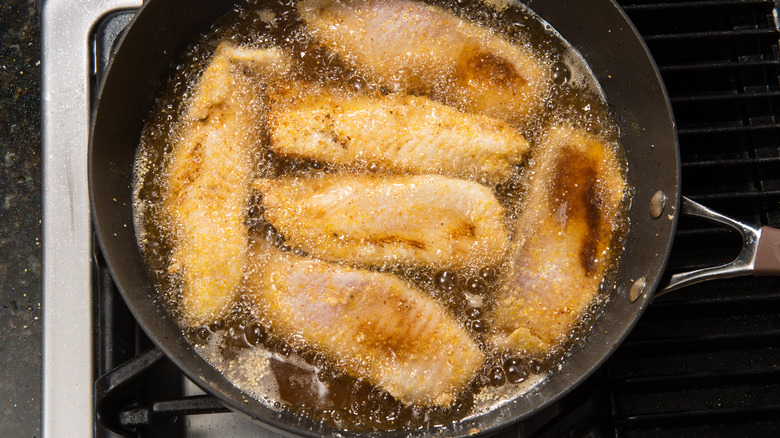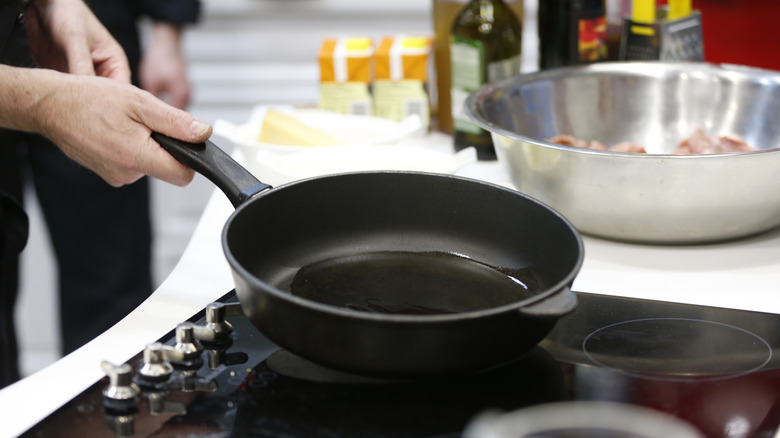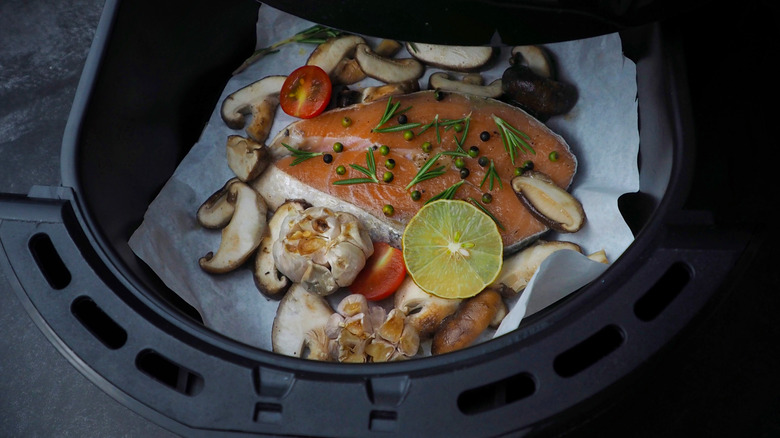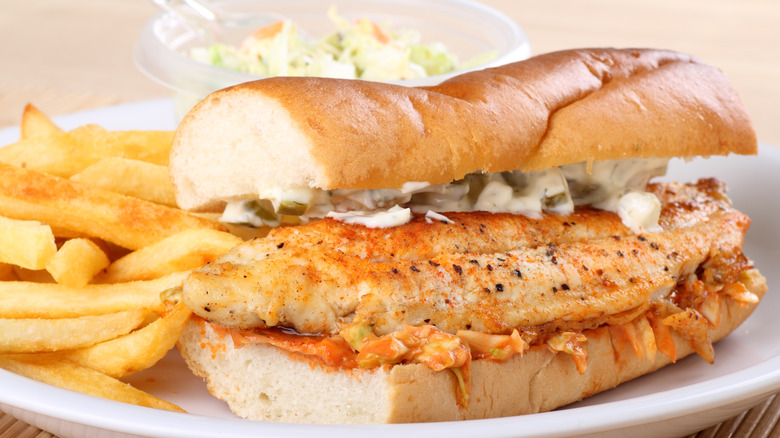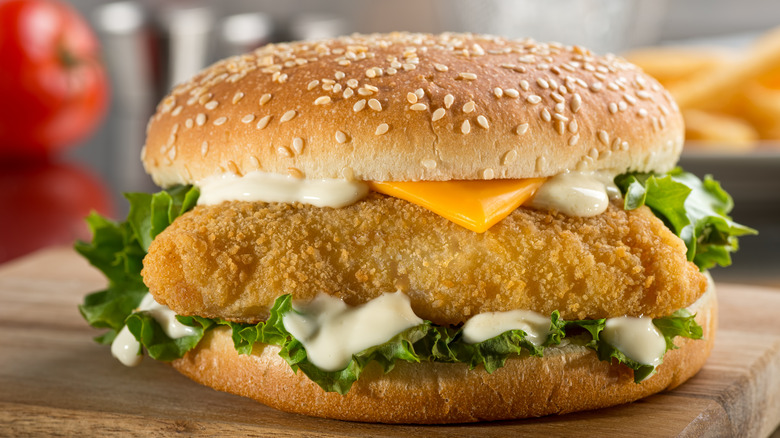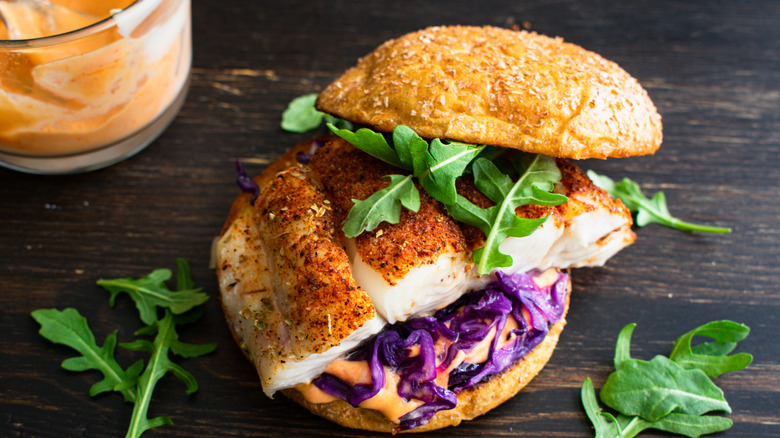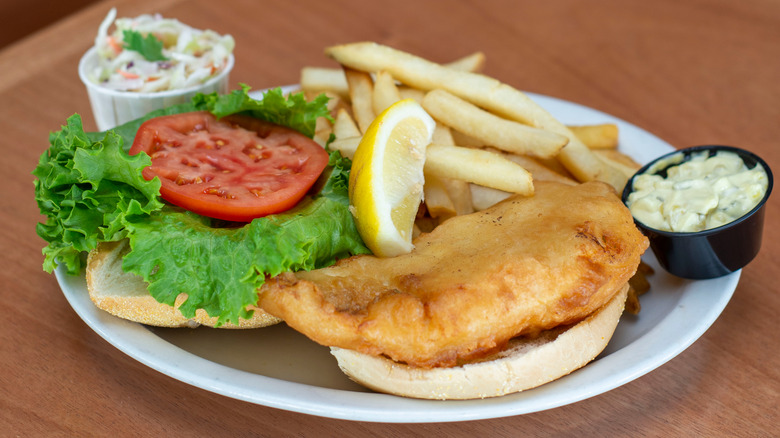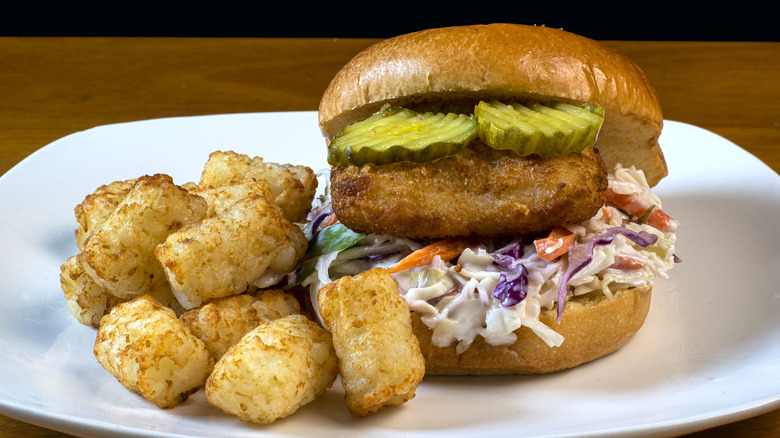15 Ways To Make Homemade Fish Sandwiches Taste So Much Better
While you can find plenty of fish sandwiches on the menu at different restaurants, there is just something special about cooking and enjoying your own creations. Plus, eating out at restaurants doesn't always fit in with a busy schedule, and it can quickly get expensive.
According to the U.S. Bureau of Labor Statistics, eating out — whether at fast food joints or sit-down restaurants — has increased by 0.6% in March of 2023. Overall, the price of "food away from home" has increased by 8.8% over the course of one year.
However, if you've tried making a few fish sandwiches and have been a bit disappointed with how they turned out, you're not alone. Perhaps the fish tasted a bit dry, or the sandwich just felt like it was missing something that you couldn't quite put your finger on. Luckily, there are several things you can do to level up your homemade fish sandwich and have it taste better than ever.
1. Change the type of fish you use
If you're not using the right type of fish or a fish that you actually like, you aren't going to enjoy your fish sandwich — no matter what you do to it. So, it's important to understand the different flavor profiles a fish can offer, as well as how they are prepared. You don't have to become an expert on all fish, but understanding even the most popular types can increase the likelihood of creating a sandwich you'll love.
For starters, salmon, tuna, tilapia, pollock, cod, and catfish are among some of the most popular fish consumed in the United States as of 2020. If you're looking for something with a milder, less "fishy" taste, opt for a white fish, like cod – there's also sole, halibut, and sea bass.
Trout and salmon can also be good choices, but they may not be the best for those new to eating fish. Trout is sweet but can have a bit of a gamey taste. Salmon is a meatier fish that many enjoy, but a few are not a fan of its flavor. If you've never had trout or salmon before and aren't sure if you like them, start with a white fish to get your palate used to new flavors.
Beyond choosing the right type of fish, always opt for fresh fish when possible. If you can purchase a piece of fish at the market that was caught earlier that day, it is going to have the best flavor and texture. If fresh fish isn't available, you can consider frozen fish over cooking something that may have been sitting around for a few days.
2. Change the way you cook the fish
Another thing that will elevate your fish sandwich is choosing the best cooking method for your taste buds. If you haven't been satisfied with the way your sandwiches have been tasting, it could mean that you either aren't cooking the fish the right way or that the cooking method you're using isn't imparting the best flavor.
One of the most popular options is frying your fish. There are a few ways to do this, but one you might want to consider is breading the fish with eggs and bread crumbs before heating it in a frying pan until both sides are a deep golden brown color. Fried fish will offer an extra crunch and flavor to a fish sandwich, which is why it is such a popular cooking method.
Of course, frying your fish isn't the only way you can cook it to make your sandwich taste incredible. You can also bake or broil the fish. Either of those options can be a solid choice if you're looking to make a healthier fish sandwich and don't want to add extra calories from the bread crumbs or oil.
3. Season the fish before cooking
Fish can be flavorful and delicious. However, without the right seasonings, it can taste a bit bland on any sandwich. One key to making fish that will taste so much better is choosing the right seasonings and adding them to the fish before cooking it. There is a wide range of seasonings that can enhance the flavor of different types of fish.
To start, consider your preferences and what you're looking for in the finished sandwich to help you decide which seasonings to use. For example, if you're looking for a stronger flavor, consider adding garlic powder, onion powder, cayenne, tarragon, oregano, or dill to your fish. If you want something a bit more subtle, consider thyme, parsley, or rosemary.
You could also cook fish with some vinegar, lemon, or lime to achieve a more sour taste. Alternatively, honey, brown sugar, or orange juice could help give your fish a sweeter flavor.
4. Learn how to properly bread fish
If you decide you want to make a fried fish sandwich, it is important to know how to properly bread the fish. You want the breading to stay on the fish, offer the right amount of crunch, and enhance the overall flavor of the fish itself and the sandwich as a whole.
To achieve these goals, the first step is to start with the right ingredients. You'll need three bowls. The first should be filled with flour and your selected seasonings. The second should have a few beaten eggs, and the last should be filled with bread crumbs.
Before you start moving the fish through the different ingredients, you should first rinse each filet off and gently pat it dry using a paper towel. Then, add a little salt and pepper directly to the fish. Take one piece of fish at a time and coat both sides with flour, the beaten eggs, and the bread crumbs. Once everything is evenly breaded, you can proceed to make the perfectly fried fish sandwich.
5. Preheat the pan before putting the fish on it
When you cook fish on the stovetop, do you let the pan heat up before putting the filet on it? If not, this is one change that you'll want to make when preparing your next fish sandwich.
Pans are covered with lines and little crevices on their surface that are often too small for our eyes to see. As the pan warms up over the stove, these little crevices expand. If you put your fish on the pan before it has heated up and before the crevices have had the opportunity to expand, the fish is going to stick to the pan. When you turn it over to cook the other side, you'll notice that small or large chunks of the fish don't come cleanly off the pan, potentially splitting your filet.
The right way to cook fish is to leave the pan over the hot burner for a minimum of 3 minutes. This will give the pan time to expand without the fish covering it. Once it is preheated, you can add the oil, followed by your fish. You'll be much happier with how evenly the fish cooks and browns, as well as how much easier cleanup will be when you allow the pan to preheat.
6. Consider cooking fish in the air fryer
If you haven't been using your air fryer to cook fish, now may be the perfect time to start — or to purchase an air fryer if you don't already have one. Air fryers can offer the best of both worlds when it comes to cooking a flavorful fish that doesn't have too many added calories from fatty oils. Because of the way an air fryer cooks and moves the hot air around all the sides of the fish, it will yield a crispy and crunchy filet without the need to use tons of oil.
In addition to helping you cook healthy yet tasty fish filets for your sandwiches, air fryers are also quick and easy to use. All you need to do is add the seasonings or breading to the fish, put it on the rack, and spray it with some cooking spray. However, if you have an air fryer that has a non-stick basket, then the spraying is completely optional, if not unnecessary. You can also place your fish on parchment paper to prevent it from sticking even further.
Then, just set the air fryer and let it cook. You don't have to babysit the pan or keep flipping the fish over as it cooks. After the fish has cooked, cleanup will be a breeze since you'll just need to clean the air fryer tray or basket.
7. Don't overcook the fish
While you want to make sure that the fish is cooked through and safe to eat, it is also important to make sure that you don't overcook it. Overcooked fish is dry and can also be overly chewy. If your fish turns out this way, it is going to have a negative impact on how tasty and enjoyable your sandwich is.
When cooking fish, you want the internal temperature to reach 140 degrees in most cases. If it gets hotter than this, that's when you're risking ending up with a tougher, drier, and chewier texture that no one wants. So, how are you supposed to know when a piece of fish has finished cooking? Beyond using a meat thermometer to verify the internal temperature, you can pay attention to how the fish responds when poked with a fork.
Poke a fork into the thickest point of the fish, holding it at a slight angle. Give the fork a gentle twist and look to see if the fish flakes when you move the fork. If it does, and it no longer looks translucent, then it is likely done and ready to enjoy. Checking for doneness after about 10 minutes is a good rule to follow for most types of fish that are about 1 inch thick — just be sure to flip the fish at about the 5-minute mark, too.
8. Don't make it ahead of time
Whenever possible, avoid making your fish sandwich ahead of time. It will have the best flavor when you cook it immediately before eating it. As the fish sits in the refrigerator, the taste will change slightly. Plus, when you go to reheat the fish, you run the risk of it drying out or becoming chewy, which will have a negative impact on your sandwich. If you do need to make the fish ahead of time, do not assemble the sandwich itself until you are ready to eat it.
Instead, warm up the fish and any other toppings separately before layering everything on the bun. If the sandwich is pre-made and you go to warm it up in the microwave, all the different ingredients will warm up at different rates, leaving some things still cold while others are getting dried out. When microwaved, bread can also get soggy — which is not great, especially for a fish sandwich.
If you warm everything up individually, you'll at least have better control to make sure each component is heated to the optimal temperature and doesn't get overheated to the point of drying out or burning your tongue.
9. Try a different type of bread
If you've been dissatisfied with the way your homemade fish sandwiches have been tasting, one simple fix that could have a big impact is to change the bread. Whether you've simply grown tired of the same bread or the type you chose just doesn't add anything extra to the sandwich, switching it to try something else may be just what your tastebuds need.
When choosing the right bread for a fish sandwich, you want to find something that will complement — not take away from — the flavor of the fish. One of the best types of bread to use for a fish sandwich is a brioche roll. Creamy seafood rolls on buttered brioche are popular for a reason. Brioche is soft and buttery, creating the perfect pairing with any seafood item.
If you prefer crispier bread, consider trying sourdough. Between its crunchy outer crust and tangy flavor, it can add a unique spin to a standard fish sandwich. Ciabatta or Italian bread are also crispier bread options that you might want to try for your fish sandwich.
10. Thaw frozen fish properly
Thawing frozen fish properly is important for more than just the way the fish will taste in your sandwich. Many people want to thaw their frozen fish filets as quickly as possible and see using hot water as a means to reach this goal. However, using hot water to thaw fish or any other seafood is not safe.
It increases the chances that parts of the fish will warm up too much, allowing bacteria to grow. Similarly, you also should never thaw fish by leaving it out on the counter at room temperature. The outer parts of the fish will get warmer than the center, creating a breeding ground for bacteria.
When possible, take your fish out several hours before you plan to cook it and leave it in the refrigerator to thaw for about six to eight hours per pound. If you don't have that many hours before you want to cook the fish, place it in a zippered bag and fully submerge the bag under cold water until its fully defrosted.
11. Add tartar sauce
There's a reason tartar sauce is almost always served with fish at restaurants. Its tangy flavor complements the flavor of most fish perfectly. If you haven't been adding tartar sauce to your homemade fish sandwiches, particularly fried fish sandwiches, you might want to rethink that decision and at least give it a try. You'll find that its addition will really help to elevate your entire meal.
While you can buy it in plenty of stores, preparing a homemade tartar sauce isn't as difficult as you might think — and it's certainly worth it. Making it yourself also allows you to have greater control over the ingredients and the final flavor. Tartar sauce is mayonnaise-based, but it also includes vinegar and other acidic ingredients that help contribute to its flavor profile.
Some of the ingredients you might want to add to your tartar sauce include olives, capers, pickles, shallots, mustard, cayenne pepper, and lemon juice. Experiment with different recipes and combinations of ingredients until you find the one that you like the best.
12. Try a unique or unexpected topping to elevate the flavor
One way to spice up a homemade fish sandwich is by adding new toppings. Consider adding avocado to your fish sandwich, as it has an earthy and buttery flavor that pairs nicely with many foods. When it comes to fish or any seafood, buttery textures and flavors are always a great option.
Plus, with its creamier consistency, you can also smear avocado on the bread like you would a spread or sauce. You can also slice it and layer it between the fish and the bun for more of a textured bite.
Pickled peppers, radishes, cabbage, or even eggs can also transform the way your fish sandwich tastes. They'll also enhance the crunch factor, making it more enjoyable to eat. Finally, if you are a fan of anything and everything hot and spicy, you may want to consider adding some hot sauce to your fish sandwich.
13. Add your favorite toppings
At the end of the day, you're only going to like a fish sandwich if you also like the toppings that are in it. While experimenting with options can help you discover new combinations, if you dislike avocado, you're not going to like a fish sandwich with avocado on it. Similarly, if you can't handle spicy foods, a fried fish sandwich with hot sauce or other spicy toppings just isn't going to be a good choice for you.
Think about some of your favorite toppings on other types of sandwiches, and consider adding them to your fish sandwich. A great example is cheese. For many people, cheese can make anything taste better. Pick your favorite cheese — perhaps American, cheddar, or pepper jack — and melt it over your fish when it is still warm off the burner or out of the oven.
No matter how random you think a topping might be, it might just make your sandwich as perfect as you need it to be. So, if you like pickles, lettuce, banana peppers, ketchup, or pineapple, play around with the foods you like best. After all, everyone has a unique palette, and only you know what tastes great for you.
14. Choose the right sides to serve with the sandwich
You should consider how the sides you're serving with your fish sandwich are adding to or taking away from how it tastes. While they shouldn't be the star of the meal, your sides shouldn't be so bland or boring that they don't contribute anything. You also don't want to choose competing flavors that don't pair well together.
For example, serving chocolate pudding on the side of your fish sandwich might not be the best combination. Fortunately, there are several side dish options that will pair beautifully with a fish sandwich. To get you started, start with the classic french fries, chips, or potato wedges. Fish and chips are a thing for a reason. However, they are far from the only option to consider.
If you're looking to add some greens to your plate, consider sautéing spinach with some garlic or making a green bean salad. You could also serve a side salad with your fish sandwiches. Other options to consider include coleslaw, potato salad, macaroni salad, or macaroni and cheese.
15. Experiment with different ingredients, combinations, and cooking methods
Ultimately, what someone else views as a delicious fish sandwich may be too bland, too spicy, or otherwise unenjoyable for your preferences. Making a fish sandwich that checks all of your boxes might take some time and experimentation. You will need to be willing to do something different than you're used to or even try out a few different ingredients that you might not normally choose. Landing on the perfect combination will be well worth the time and effort.
To keep yourself from getting tired of one particular type of fish sandwich, consider switching things up every now and then to keep them exciting. Alternate between frying and baking the fish for your sandwich, using different types of fish, testing out different spices, and rotating through different toppings. Using this strategy can help make each fish sandwich better than your last.


